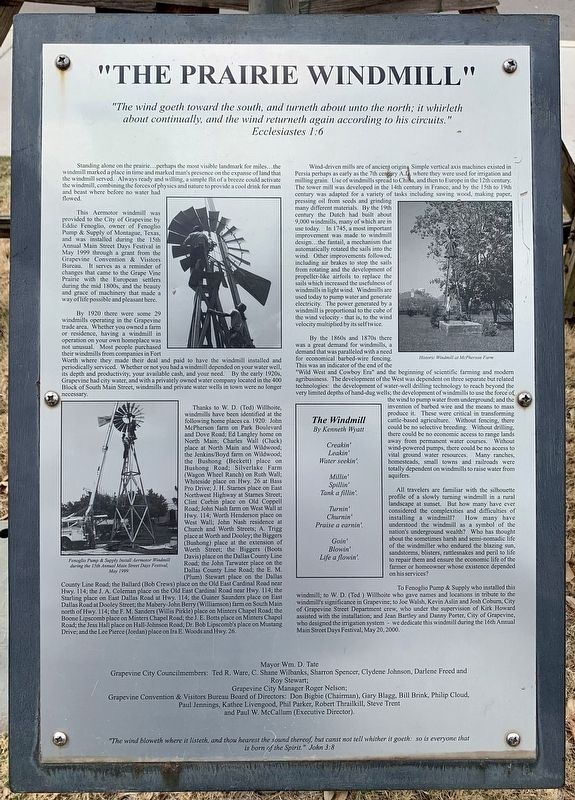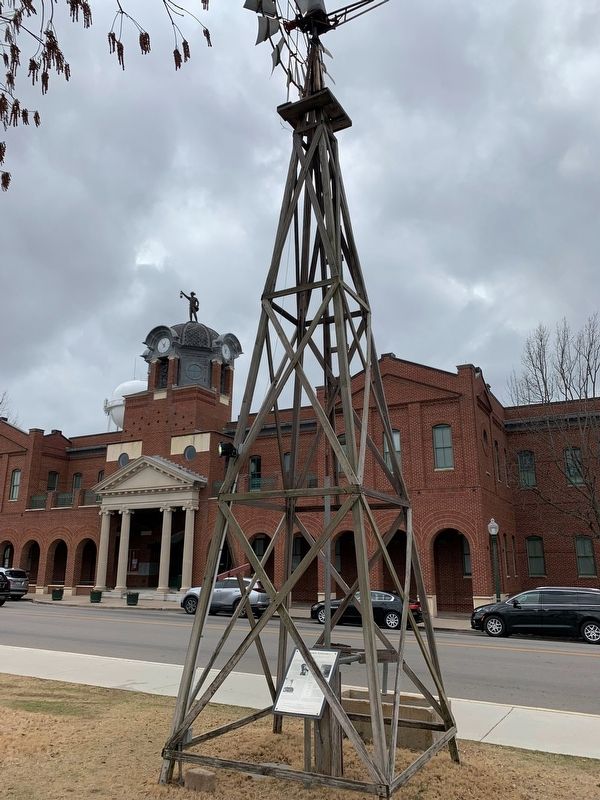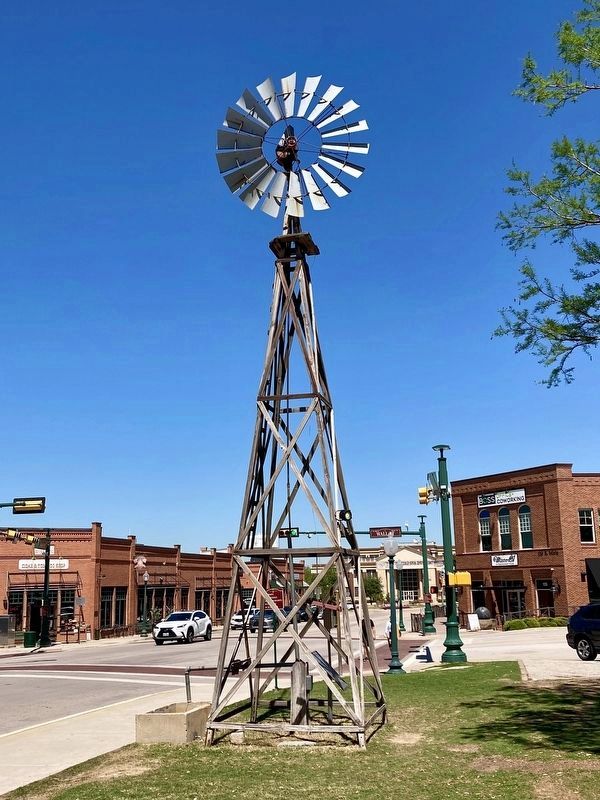Grapevine in Tarrant County, Texas — The American South (West South Central)
"The Prairie Windmill"
"The wind goeth toward the south, and turneth about unto the north; it whirleth about continually, and the wind returneth again according to his circuits."
Ecclesiastes 1:6
Standing alone on the prairie...perhaps the most visible landmark for miles...the windmill marked a place in time and marked man's presence on the expanse of land that the windmill served. Always ready and willing, a simple flit of a breeze could activate the windmill, combining the forces of physics and nature to provide a cool drink for man and beast where before no water had flowed.
This Aermotor windmill was provided to the City of Grapevine by Eddie Fenoglio, owner of Fenoglio Pump & Supply of Montague, Texas, and was installed during the 15th Annual Main Street Days Festival in May 1999 through a grant from the Grapevine Convention & Visitors Bureau. It serves as a reminder of changes that came to the Grape Vine Prairie with the European settlers during the mid 1800s, and the beauty and grace of machinery that made a way of life possible and pleasant here.
By 1920 there were some 29 windmills operating in the Grapevine trade area. Whether you owned a farm or residence, having a windmill in operation on your own home place was not unusual. Most people purchased their windmills from companies in Fort Worth where they made their deal and paid to have the windmill installed and periodically serviced. Whether or not you had a windmill depended on your water well, its depth and productivity, your available cash, and your need.
By the early 1920s, Grapevine had city water, and with a privately owned water company located in the 400 Block of South Main Street, windmills and private water wells in town were no longer necessary.
Thanks to W. D. (Ted) Willhoite, windmills have been identified at the The Windmill By Kenneth Wyatt following home places ca. 1920: John McPherson farm on Park Boulevard and Dove Road; Ed Langley home on North Main; Charles Wall (Cluck) place at North Main and Wildwood; the Jenkins/Boyd farm on Wildwood; the Bushong (Beckett) place on Bushong Road; Silverlake Farm (Wagon Wheel Ranch) on Ruth Wall; Whiteside place on Hwy. 26 at Bass Pro Drive; J. H. Starnes place on East Northwest Highway at Starnes Street; Clint Corbin place on Old Coppell Road; John Nash farm on West Wall at Hwy. 114; Worth Henderson place on West Wall; John Nash residence at Church and Worth Streets; A. Trigg place at Worth and Dooley; the Biggers (Bushong) place at the extension of Worth Street; the Biggers (Boots Davis) place on the Dallas County Line Road; the John Tarwater place on the Dallas County Line Road; the E. M. (Plum) Stewart place on the Dallas County Line Road; the E. M. (Plum) Stewart place on the Dallas County Line Road; the Ballard (Bob Crews) place on the East Cardinal road near Hwy 114; the J. A. Coleman place on the Old East cardinal road near Hwy. 114; the Starling place on East Dallas Road at Hwy. 114; the Guiner Saunders place on East Dallas at Dooley street; The Mabery - John Berry ( Williamson) farm on South Mainnorth of Hwy. 114; the F. M. sanders ( Willis Pirkle) place on Minters Chapel Road; the Boone Lipscomb place on Minters Chapel Road; the J. E. Botts place on Minters Chapel Road; the Jess Hall place Hall - Johnson Road; Dr. Bob Lipscomb's Place on Mustang Drive; and the Lee Pierce (Jordan) place on Ira E. Woods and Hwy. 26.
Wind-driven mills are of ancient origin. Simple vertical axis machines existed in Persia perhaps as early as the 7th century A.D where they were used for irrigation and milling grain. Use of windmills spread to China, and then to Europe in the 12th century. The tower mill was developed in the 14th century in France, and by the 15th to 19th century was adapted for a variety of tasks including sawing wood, making paper, pressing oil from seeds and grinding many different materials. By the 19th century the Dutch had built about 9,000 windmills, many of which are in use today. In 1745, a most important improvement was made to windmill design... the fantail, a mechanism that automatically rotated the sails into the wind. Other improvements followed, including air brakes to stop the sails from rotating and the development of propeller-like airfoils to replace the sails which increased the usefulness of windmills in light wind. Windmills are used today to pump water and generate electricity. The power generated by a windmill is proportional to the cube of the wind velocity that is, to the wind velocity multiplied by its self twice.
By the 1860s and 1870s there was a great demand for windmills, a demand that was paralleled with a need for economical barbed-wire fencing. This was an indicator of the end of the Historic Windmill at McPherson Farm "Wild West and Cowboy Era” and the beginning of scientific farming and modern agribusiness. The development of the West was dependent on three separate but related technologies: the development of water-well drilling technology to reach beyond the very limited depths of hand-dug wells; the development of windmills to use the force of the wind to pump water from underground; and the invention of barbed wire and the means to mass produce it. These were critical in transforming cattle-based agriculture. Without fencing, there could be no selective breeding. Without drilling, there could be no economic access to range lands away from permanent water courses. Without wind - powered pumps, there could be no access to vital ground water resources. many ranches, homesteads, small towns and railroads were totally dependent on windmills to raise water from aquifers.
All travelers are familiar with the silhouette profile of a slowly turning windmill in a rural landscape at sunset. But how many have ever considered the complexities and difficulties of installing a windmill? How many have understood the windmill as a symbol of the nation's underground wealth? Who has thought about the sometimes harsh and semi-nomadic life of the windmiller who endured the blazing sun, sandstorms, blisters, rattlesnakes and peril to life to repair them and ensure the economic life of the farmer or homeowner whose existence depended on his services?
To Fenoglio Pump & Supply who installed this windmill; to W. D. (Ted ) Willhoite who gave names and locations in tribute to the windmill's significance in Grapevine; to Joe Walsh, Kevin Aslin and Josh Coburn, City of Grapevine Street Department crew, who under the supervision of Kirk Howard assisted with the installation; and Jean Bartley and Danny Porter, City of Grapevine, who designed the irrigation system - we dedicate this windmill during the 16th Annual Main Street Days Festival, May 20, 2000.
Mayor Wm. D. Tate
Grapevine City Councilmembers: Ted R. Ware, C. Shane Wilbanks, Sharron Spencer, Clydene Johnson, Darlene Freed and Roy Stewart;
Grapevine City Manager Roger Nelson;
Grapevine Convention & Visitors Bureau Board of Directors: Don Bigbie (Chairman), Gary Blagg, Bill Brink, Philip Cloud, Paul Jennings, Kathee Livengood, Phil Parker, Robert Thrailkill, Steve Trent and Paul W. McCallum (Executive Director).
"The wind bloweth where it listeth, and thou hearest the sound thereof, but canst not tell whither it goeth: so is everyone that is born of the Spirit.” John 3:8
Topics. This historical marker is listed in these topic lists: Industry & Commerce • Settlements & Settlers.
Location. 32° 56.365′ N, 97° 4.694′ W. Marker is in Grapevine, Texas, in Tarrant County. Marker is on South Main Street, 0.1 miles north of East Texas Street, on the right when traveling north. Touch for map. Marker is in this post office area: Grapevine TX 76051, United States of America. Touch for directions.
Other nearby markers. At least 8 other markers are within walking distance of this marker. Torian Log Cabin (a few steps from this marker); Grapevine (a few steps from this marker); Grapevine's Liberty Bell (within shouting distance of this marker); a different marker also named Torian Log Cabin (within shouting distance of this marker); Grapevine, Texas (within shouting distance of this marker); The Wallis Hotel (within shouting distance of this marker); Benjamin Richard Wall (within shouting distance of this marker); Palace Theatre (within shouting distance of this marker). Touch for a list and map of all markers in Grapevine.
Credits. This page was last revised on April 15, 2024. It was originally submitted on March 23, 2022, by Thomas Smith of Waterloo, Ill. This page has been viewed 299 times since then and 48 times this year. Photos: 1. submitted on March 23, 2022, by Thomas Smith of Waterloo, Ill. 2. submitted on March 27, 2022, by Thomas Smith of Waterloo, Ill. 3. submitted on April 10, 2024, by Craig Baker of Sylmar, California. • J. Makali Bruton was the editor who published this page.


